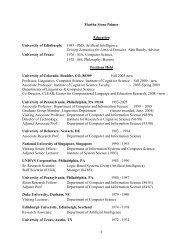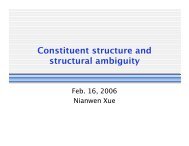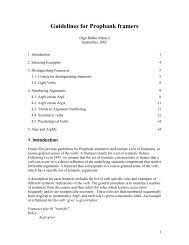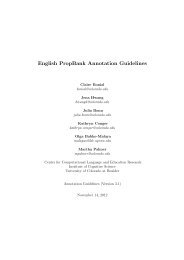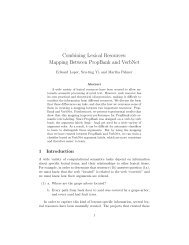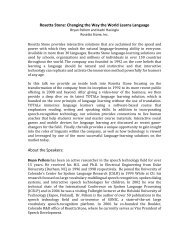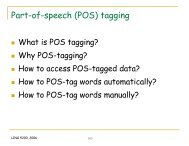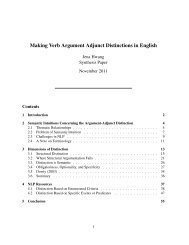Hindi PropBank Annotation Guidelines December ... - Verbs Index
Hindi PropBank Annotation Guidelines December ... - Verbs Index
Hindi PropBank Annotation Guidelines December ... - Verbs Index
You also want an ePaper? Increase the reach of your titles
YUMPU automatically turns print PDFs into web optimized ePapers that Google loves.
these cases, the argument should be annotated as the numbered argument as<br />
opposed to the reciprocal modifier.<br />
46. Mohan aur siitaa ne [ ARGM-REC ek saath] kaam kiyaa.<br />
Mohan and Siitaa erg together work did<br />
‘Mohan and siitaa worked together’<br />
47. mohan ne [ ARGM-REC apne aap] kaam kiyaa.<br />
Mohan erg by-himelf work did<br />
‘Mohan worked by himself’<br />
Note that the reciprocal is not an ARGM_REC in the following sentence, since they<br />
function as an argument.<br />
48. Mohan aur raam ne ek duusre ko dekhaa.<br />
Mohan and Raam erg one another Dat looked.<br />
‘Mohan and Ram looked at each other’<br />
4.9. ARGM_PRD: markers of secondary predication (PRD)<br />
These are used to show that an adjunct of a predicate is in itself capable of carrying<br />
some predicate structure. In <strong>Hindi</strong>, secondary predication does not appear to be as<br />
productive as it is in English. A typical example might include:<br />
49. bacce ne seb ko [ ARGM-PRD choTe-choTe TukRon mein] kaaTaa<br />
child erg apple dat small-small pieces in cut.<br />
‘The child cut the apple in little pieces’<br />
4.10. ARGM_PRP<br />
Purpose clauses are used to show the motivation for some action. Clauses beginning<br />
with "in order to" are canonical purpose clauses.<br />
50. maine [ ARGM-PRP dillii jaane ke liye] Tikata khariida.<br />
I-erg Delhi go-inf for ticket bought<br />
‘I bought tickets in order to go to Delhi.’<br />
38



